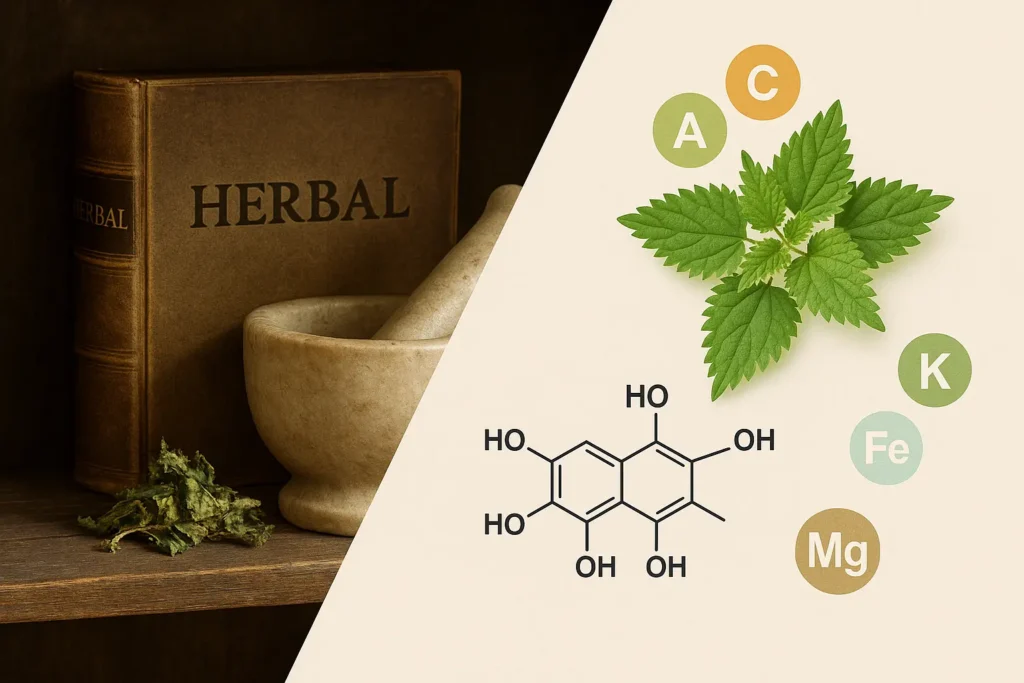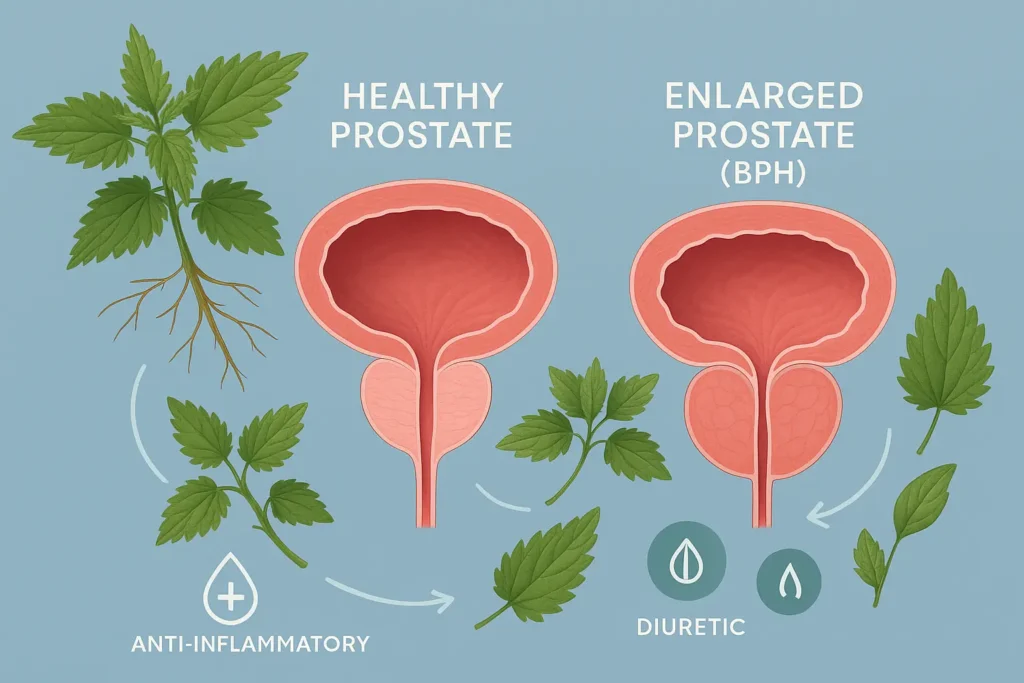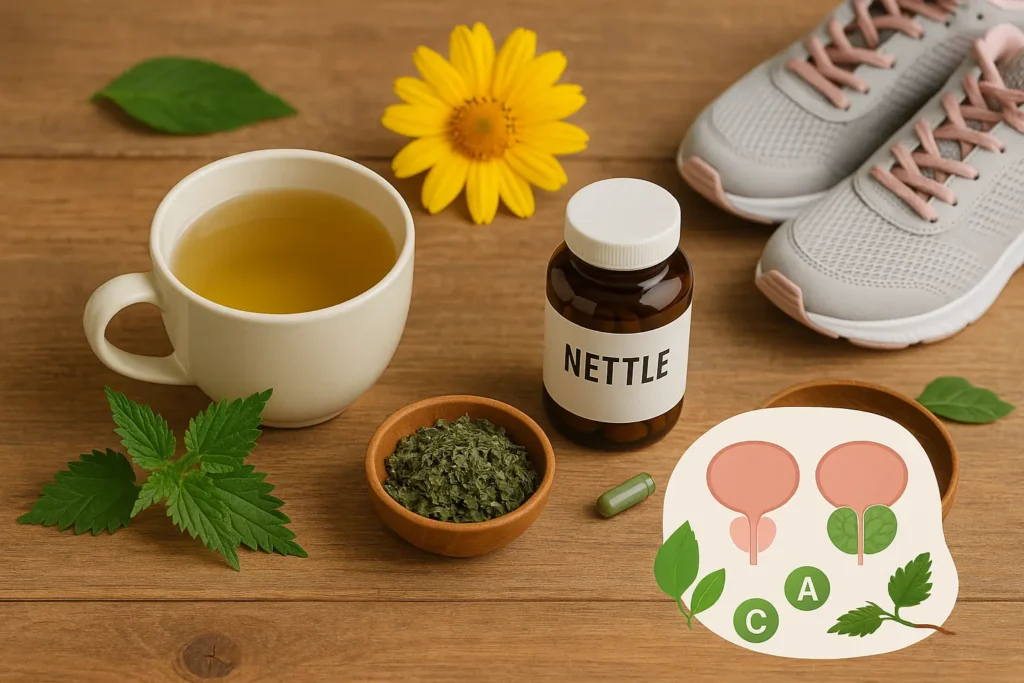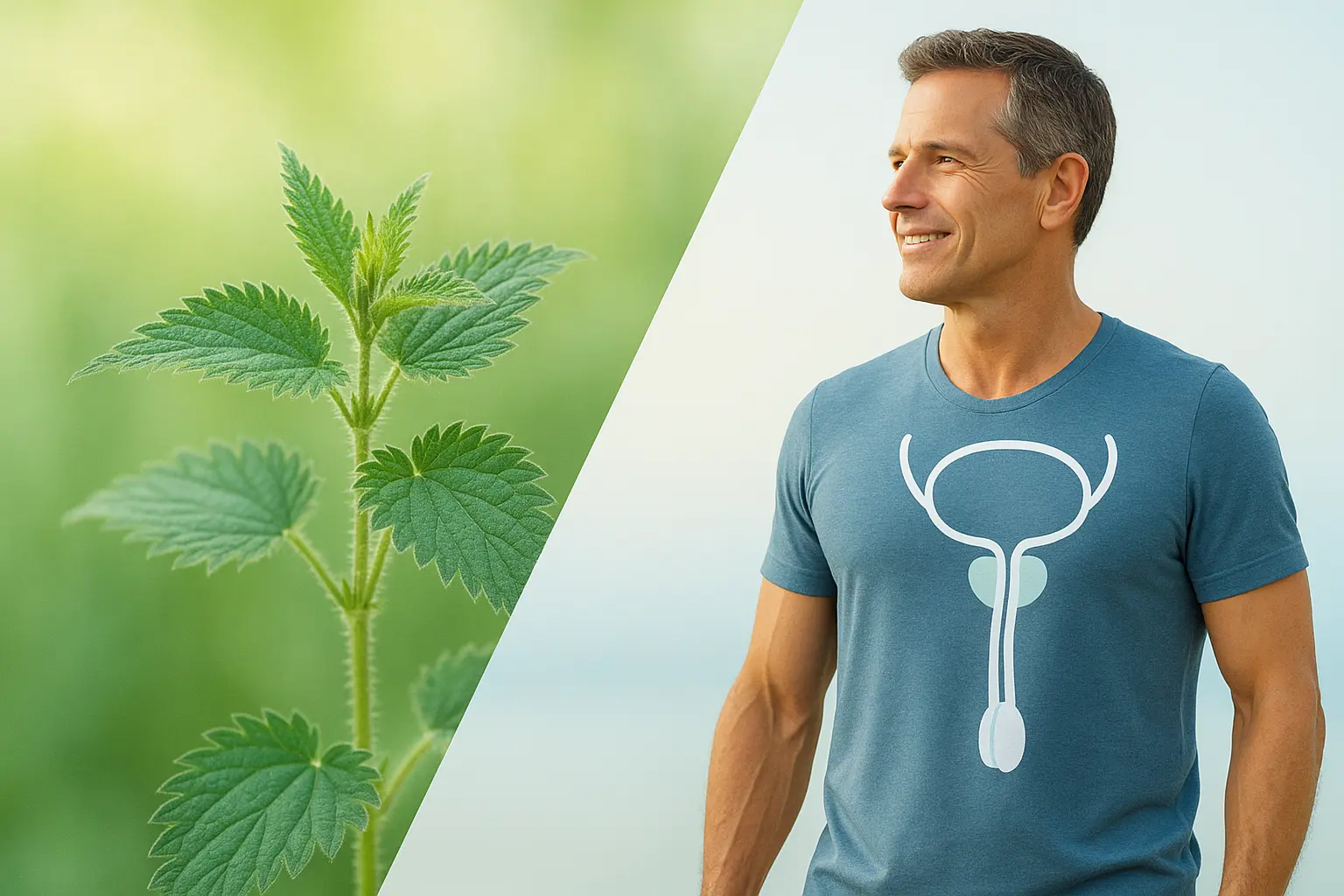Stinging Nettle, a plant as intriguing as its name, has woven itself into the fabric of both history and modern herbal medicine, revealing a story rich in both culture and healing.
Overview of What Stinging Nettle Is Stinging Nettle, or Urtica dioica, is not just a common weed; it’s a powerhouse of nutrients and therapeutic potential. This perennial plant, easily recognized by its heart-shaped leaves and signature sting, has been used for centuries in various cultures for its medicinal properties. It’s found in many parts of the world, thriving in nitrogen-rich soils.
The ‘sting’ comes from tiny hairs on its leaves and stems, which release chemicals upon contact. Far from just an irritant, these chemicals are part of what makes Stinging Nettle so beneficial. The plant is rich in vitamins A, C, and K, minerals like iron and magnesium, and a host of polyphenols and amino acids.
Historical and Cultural Significance The history of Stinging Nettle as a medicinal herb is both rich and varied. It was used by ancient Egyptians to treat arthritis and lower back pain. In medieval Europe, it was a staple in herbal medicine, utilized for its diuretic and anti-inflammatory properties. In traditional Native American culture, it served as a remedy for various ailments, including joint pain and muscle soreness.
Beyond its medicinal use, Stinging Nettle has played a role in the textile industry, used to make durable cloth similar to linen, especially during periods when cotton or other fibers were scarce.
Stinging Nettle and Prostate Health
Stinging Nettle, long celebrated in the realm of natural remedies, emerges as a significant player in promoting prostate health, offering a beacon of hope for those dealing with prostate-related concerns.
Benefits of Stinging Nettle for Prostate Wellness The relationship between Stinging Nettle and prostate health is grounded in the plant’s unique composition, which makes it particularly beneficial for men’s health, especially in maintaining a healthy prostate. Rich in bioactive compounds, Stinging Nettle provides a range of nutrients that are thought to have a direct positive impact on prostate health.
One of the key benefits of Stinging Nettle in this context is its potential to alleviate symptoms associated with Benign Prostatic Hyperplasia (BPH), a common condition in men as they age, characterized by the enlargement of the prostate gland. The compounds in Stinging Nettle are believed to help reduce the size of the prostate and ease symptoms such as urinary frequency, incomplete bladder emptying, and a weak urine stream.
Its Role in Managing Conditions Like Benign Prostatic Hyperplasia (BPH) Stinging Nettle works in several ways to aid those with BPH. Its anti-inflammatory properties are vital in reducing the swelling of the prostate, thereby alleviating discomfort. Additionally, the plant’s natural diuretic effect helps in improving urinary flow and relieving the symptoms of an overactive bladder, a common complaint among BPH sufferers.
Further, Stinging Nettle is thought to interfere with the conversion of testosterone to dihydrotestosterone (DHT), a hormone linked to prostate enlargement. By inhibiting this conversion, Stinging Nettle may help prevent or slow down the progression of BPH.
Nutritional Composition of Stinging Nettle
Stinging Nettle, often perceived as a simple weed, is in fact a nutritional powerhouse, brimming with elements essential for maintaining robust health.
Analysis of Vitamins, Minerals, and Phytonutrients Stinging Nettle is an impressive source of nutrients. It’s rich in vitamins, including Vitamin A, C, and K, along with several of the B vitamins. These vitamins are essential for maintaining good vision, immune function, blood clotting, and energy production.
The mineral content in Stinging Nettle is equally noteworthy. It boasts high levels of iron, essential for forming red blood cells and preventing anemia. Calcium and magnesium, vital for bone health and muscle function, are also found in abundance. Potassium, crucial for heart health, and manganese, important for bone development and metabolism, further enrich its profile.
Apart from these, Stinging Nettle is packed with phytonutrients – plant compounds that have anti-inflammatory and antioxidant properties. These include beta-carotene, quercetin, and other flavonoids. These phytonutrients not only help in combating inflammation but also protect the body against oxidative stress, which can lead to chronic diseases.
How These Contribute to Health The blend of vitamins, minerals, and phytonutrients in Stinging Nettle contributes to its many health benefits. The anti-inflammatory properties can alleviate conditions like arthritis and prostatitis, while the antioxidants help in neutralizing harmful free radicals in the body. The rich iron content makes it beneficial for blood health, and the high potassium levels contribute to a healthy heart.
Its nutrient density also makes Stinging Nettle a valuable addition to any diet, particularly for those looking to boost their nutrient intake naturally. Whether consumed as a tea, in soups, or as a supplement, Stinging Nettle provides a natural, nutrient-rich boost to your daily health regimen.

Stinging Nettle in Traditional Medicine
The journey of Stinging Nettle from ancient herbal lore to contemporary wellness circles is a rich tapestry of tradition and healing wisdom.
Historical Uses in Herbal Practices Stinging Nettle has been a staple in traditional medicine for centuries, revered for its wide array of health benefits. Historically, it has been used across various cultures for its medicinal properties. In ancient Greek and Roman societies, Stinging Nettle was a popular remedy for joint pain and muscle soreness. It was also used as a diuretic to relieve fluid retention and to cleanse the blood.
In medieval Europe, Stinging Nettle was a common treatment for skin issues and as a tonic for hair growth. Its use in Native American medicine was equally diverse, ranging from a general wellness tonic to treatments for kidney and joint problems.
The versatility of Stinging Nettle in traditional medicine stems from its rich nutritional profile, including vitamins, minerals, and anti-inflammatory compounds, making it a go-to remedy for a wide range of ailments.
Evolution into Modern Herbal Therapy In modern herbal therapy, Stinging Nettle has found a new lease of life. Its historical uses have been validated and expanded upon through scientific research. Today, it’s used not only for its traditional benefits but also for new applications discovered through modern research, such as its effectiveness in alleviating symptoms of benign prostatic hyperplasia (BPH) and its role in alleviating allergies.
This evolution from traditional to modern usage highlights the adaptability and enduring relevance of Stinging Nettle in the ever-evolving world of natural health. It continues to be a valued ingredient in herbal supplements, teas, and tinctures, cherished for both its historical significance and contemporary applications.
Stinging Nettle for Allergy Relief
Stinging Nettle emerges as a natural ally in the battle against allergies, offering a breath of fresh air to those who suffer from seasonal sniffles and sneezes.
Understanding Its Anti-Allergic Properties The power of Stinging Nettle in combating allergies lies in its natural antihistamine properties. Histamines are the chemicals in the body that cause many of the unpleasant symptoms associated with allergies, such as sneezing, itching, and runny nose. Stinging Nettle contains compounds that can naturally inhibit the release of histamines, thereby reducing these symptoms.
Additionally, Stinging Nettle is rich in bioactive compounds like quercetin, which has been shown to stabilize mast cells that release histamine and other inflammatory signals. This stabilization helps in managing allergic reactions by minimizing the body’s response to allergens.
Benefits for Seasonal Allergy Sufferers For those who face the seasonal challenges of pollen, dust, and other environmental allergens, Stinging Nettle can be a game-changer. By mitigating the body’s allergic response, it can provide relief from common symptoms like nasal congestion, watery eyes, and sneezing. Unlike many over-the-counter allergy medications, Stinging Nettle does this without causing drowsiness, making it an attractive option for those seeking a natural remedy.
The effectiveness of Stinging Nettle in allergy relief has been recognized in various studies, with many users reporting significant improvements in their symptoms. Incorporating Stinging Nettle into a daily routine during allergy season – either as a supplement, tea, or tincture – can help manage symptoms and improve quality of life for allergy sufferers.
Anti-Inflammatory and Pain Relief Properties
Stinging Nettle, a plant often encountered with caution due to its prickly demeanor, harbors potent anti-inflammatory and pain-relieving properties, making it a natural ally in the fight against chronic pain and inflammation.
How Stinging Nettle Reduces Inflammation The anti-inflammatory prowess of Stinging Nettle lies in its unique blend of natural compounds. It contains a variety of bioactive components, including flavonoids like quercetin and plant sterols, which are known for their anti-inflammatory effects. These compounds work by inhibiting the production of inflammatory substances in the body, such as prostaglandins and cytokines.
Furthermore, Stinging Nettle’s ability to suppress the activation of nuclear factor-kappa B, a key molecule involved in the inflammatory process, plays a critical role in its anti-inflammatory action. This suppression helps reduce the body’s inflammatory responses, providing relief in conditions characterized by chronic inflammation, such as arthritis.
Its Role in Pain Management Stinging Nettle’s impact extends beyond reducing inflammation; it also offers pain relief. For individuals suffering from conditions like osteoarthritis, where joint pain is a common symptom, Stinging Nettle can provide significant relief. This is primarily due to its anti-inflammatory action, which helps alleviate the underlying cause of the pain.
Moreover, the analgesic (pain-relieving) properties of Stinging Nettle make it beneficial in managing muscle pain and soreness. Whether used topically or consumed in the form of tea or supplements, Stinging Nettle can help soothe pain, enhancing mobility and quality of life for those dealing with chronic pain conditions.
Stinging Nettle for Respiratory Health
Stinging Nettle, a plant often overlooked in the wild, emerges as a valuable ally in supporting respiratory health, particularly for those suffering from conditions like asthma.
Efficacy in Treating Respiratory Conditions like Asthma Asthma, characterized by chronic inflammation of the airways, can significantly impact the quality of life. Stinging Nettle has shown promise in providing relief for asthma and other respiratory conditions. Its efficacy is largely attributed to its anti-inflammatory properties, which are beneficial in reducing the airway inflammation associated with asthma.
In addition to its anti-inflammatory effects, Stinging Nettle is believed to contain natural antihistamines. These compounds help in reducing allergic reactions, which are often triggers for asthma attacks. By mitigating the body’s allergic response, Stinging Nettle can help reduce the frequency and severity of asthma symptoms, such as wheezing, coughing, and shortness of breath.
Mechanism of Action The mechanism by which Stinging Nettle aids respiratory health is twofold. First, its anti-inflammatory compounds help soothe inflamed airways, making breathing easier for asthma sufferers. Secondly, the presence of natural histamine blockers in Stinging Nettle helps prevent the allergic reactions that can trigger asthma symptoms.
Furthermore, Stinging Nettle’s expectorant properties aid in clearing mucus from the lungs, providing additional relief for those with respiratory conditions. This expectorant action makes it beneficial not just for asthma but also for other common respiratory issues like bronchitis.

Stinging Nettle as a Natural Diuretic
Stinging Nettle, with its natural diuretic properties, stands as a guardian of urinary and kidney health, offering significant benefits, particularly for men’s prostate health.
Benefits in Urinary Tract and Kidney Health The diuretic properties of Stinging Nettle are pivotal in promoting urinary tract and kidney health. As a natural diuretic, it helps increase urine production, facilitating the removal of waste products and excess fluid from the body. This process is beneficial for flushing out bacteria from the urinary tract, thereby reducing the risk of urinary tract infections (UTIs).
Moreover, the increased urine flow can also help prevent the formation of kidney stones. By keeping the kidneys flushed and reducing the concentration of minerals that can form stones, Stinging Nettle acts as a natural preventive measure against this painful condition.
Implications for Prostate Health The diuretic effect of Stinging Nettle is particularly beneficial for prostate health, especially for men dealing with benign prostatic hyperplasia (BPH). BPH can lead to urinary issues such as difficulty in starting urination, a weak urine stream, and frequent urination, especially at night. The use of Stinging Nettle can help alleviate these symptoms by improving urinary flow and reducing the frequency of urination.
In addition to its diuretic action, the anti-inflammatory properties of Stinging Nettle contribute to its benefits for prostate health. By reducing inflammation in the prostate, it helps to ease symptoms associated with BPH and prostatitis, a condition characterized by inflammation of the prostate gland.
Potential Side Effects and Safety Precautions
While Stinging Nettle is revered for its myriad health benefits, awareness of its potential side effects and adherence to safety precautions are crucial for its responsible and effective use.
Common Side Effects Stinging Nettle is generally well-tolerated, but like any herbal remedy, it can have side effects, especially if not used properly. The most common side effect is, unsurprisingly, skin irritation, which primarily occurs when the fresh plant comes into contact with the skin. This can cause a temporary rash or itching, typically due to the plant’s hair-like structures.
When consumed as a supplement, tea, or extract, Stinging Nettle can sometimes cause mild stomach upset, diarrhea, or allergic reactions in some individuals. It’s important to start with a lower dose to assess tolerance and then gradually increase as needed.
For those using Stinging Nettle as a diuretic, it’s crucial to maintain adequate hydration, as increased urination can lead to dehydration if fluid intake isn’t adjusted accordingly.
Guidelines for Safe Consumption
- Consult a Healthcare Professional: Before adding Stinging Nettle to your health regimen, especially if you have existing health conditions or are on medication, consult a healthcare provider.
- Start with Low Doses: Begin with smaller amounts to see how your body reacts and gradually increase to the recommended dosage.
- Avoid Raw Contact: When handling fresh Stinging Nettle, wear gloves to avoid skin irritation.
- Watch for Allergic Reactions: If you experience symptoms of an allergic reaction, such as hives, swelling, or difficulty breathing, discontinue use immediately and seek medical attention.
- Monitor Interactions: Stinging Nettle can interact with certain medications, including blood thinners, blood pressure drugs, and diuretics. Be mindful of potential interactions.
- Pregnancy and Breastfeeding: Due to a lack of research, pregnant or breastfeeding women should avoid using Stinging Nettle.

Stinging Nettle in Modern Clinical Research
In the realm of modern clinical research, Stinging Nettle has sparked a growing interest among scientists and health practitioners, unveiling its potential through a lens of empirical evidence and scientific inquiry.
Overview of Recent Studies and Findings Recent clinical research has begun to shed light on the therapeutic potential of Stinging Nettle, affirming and expanding upon its traditional uses. One significant area of study is its impact on prostate health. Several studies have explored Stinging Nettle’s role in managing symptoms of benign prostatic hyperplasia (BPH), with findings suggesting that it can help reduce prostate size and alleviate urinary difficulties associated with the condition.
Another notable area of research focuses on Stinging Nettle’s anti-inflammatory properties. Clinical trials have investigated its efficacy in treating conditions like osteoarthritis and hay fever. Results indicate that Stinging Nettle can reduce pain and inflammation related to arthritis and may decrease the severity of allergic reactions in hay fever.
In terms of respiratory health, research is uncovering how Stinging Nettle’s natural antihistamine properties make it a viable option for managing symptoms of asthma and other respiratory conditions.
Emerging Trends in Stinging Nettle Research As interest in natural and holistic therapies grows, Stinging Nettle is at the forefront of emerging trends in herbal medicine research. There is an increasing focus on understanding its broader application in chronic disease prevention, immune system support, and overall wellness.
Studies are also delving into the potential of Stinging Nettle in managing blood sugar levels, thus opening avenues in diabetes research. Additionally, its role in women’s health, particularly in managing symptoms associated with menopause, is an area garnering attention.
Preparing and Using Stinging Nettle
Stinging Nettle, a versatile herb in the world of natural remedies, can be prepared and used in various forms, each offering unique benefits and applications for daily health and wellness.
Various Forms and How to Use Them Effectively
- Fresh Leaves: Fresh Stinging Nettle leaves can be used in cooking, similar to spinach. However, it’s important to blanch the leaves first to remove the stinging chemicals. These blanched leaves can be added to soups, stews, or sautéed as a nutritious side dish.
- Dried Leaves: Dried Stinging Nettle leaves are commonly used to make herbal tea. Steep about one to two teaspoons of dried leaves in hot water for 10 minutes. This tea can be enjoyed daily for its detoxifying and anti-inflammatory benefits.
- Capsules and Supplements: For those seeking a more convenient option, Stinging Nettle is available in capsule or tablet form. These are typically taken according to the dosage instructions on the package and are a straightforward way to incorporate Stinging Nettle into your health regimen.
- Tinctures and Extracts: Liquid forms like tinctures and extracts are another way to consume Stinging Nettle. They are often used for more concentrated therapeutic needs and can be added to water or tea.
- Topical Applications: For skin conditions or joint pain, Stinging Nettle can be used topically in the form of creams or ointments.
Recipes and Preparations for Daily Use
- Stinging Nettle Soup: A nourishing soup can be made by sautéing onions, garlic, and potatoes, adding blanched Stinging Nettle leaves, and simmering in vegetable or chicken broth. Blend for a smooth texture and season as desired.
- Stinging Nettle Pesto: Blend blanched Stinging Nettle leaves with olive oil, garlic, pine nuts, and Parmesan cheese for a healthful and delicious pesto sauce.
- Herbal Tea Blend: Combine dried Stinging Nettle leaves with other herbs like peppermint or chamomile for a soothing herbal tea blend.
Consumer Guide: Selecting High-Quality Stinging Nettle Products
In the quest for harnessing the full potential of Stinging Nettle, choosing high-quality products is paramount. Whether you’re selecting supplements or teas, understanding what to look for can ensure you receive the maximum health benefits this remarkable herb offers.
Tips on Choosing Effective Supplements and Teas
- Look for Purity: When selecting Stinging Nettle supplements, check for products that contain pure Stinging Nettle extract without unnecessary fillers or additives. The ingredient list should be straightforward and free from artificial substances.
- Standardized Extracts: Opt for supplements that specify that they contain standardized extracts of Stinging Nettle. This standardization ensures a consistent level of active ingredients in each dose, enhancing effectiveness.
- Organic and Non-GMO: If possible, choose organic and non-GMO Stinging Nettle products. Organic products are free from pesticides and chemicals, ensuring a cleaner and more natural product.
- Reputable Brands: Purchase from reputable brands and suppliers known for their quality and transparency. Researching brand reviews and product feedback can be insightful.
- Correct Form for Your Needs: Stinging Nettle is available in various forms, including capsules, powders, teas, and tinctures. Consider the form that best suits your lifestyle and health goals.
- Tea Quality: For Stinging Nettle tea, look for whole leaf options rather than tea dust or fannings. Whole leaf teas tend to preserve more of the plant’s beneficial properties.
- Expiry and Batch Dates: Check for the product’s expiry date and batch numbers, ensuring freshness and traceability.
- Third-Party Testing: Products that have undergone third-party testing for quality assurance provide an additional layer of trust and reliability.
Conclusion
As we conclude our enlightening journey through the world of Stinging Nettle, it’s clear that this humble plant is not just a feature of the wild but a powerful ally in our quest for health and wellness.
Stinging Nettle, with its rich tapestry of nutrients and therapeutic properties, stands as a testament to the power of natural remedies. Its anti-inflammatory, diuretic, and antihistamine properties have shown to be instrumental in addressing a variety of health concerns, from respiratory conditions like asthma to the alleviation of allergic symptoms.
Particularly noteworthy is Stinging Nettle’s role in promoting prostate health. For men grappling with the challenges of conditions like benign prostatic hyperplasia (BPH), Stinging Nettle offers a beacon of hope, a natural avenue for relief and comfort.
The journey with Stinging Nettle, however, is more than about addressing specific health concerns; it’s about embracing a holistic approach to wellness. Incorporating Stinging Nettle into our daily routines, be it through teas, supplements, or culinary uses, is a step towards harmonizing with nature’s rhythm and tapping into its reservoir of healing.
As we step forward, let the story of Stinging Nettle inspire us to explore the vast and vibrant world of herbal remedies. Let it remind us that sometimes, the most profound healing can come from the simplest of sources. Here’s to health, naturally nurtured, and lives, vibrantly lived!
Resources
- National Center for Complementary and Integrative Health (NCCIH): This resource provides comprehensive and research-based information on Stinging Nettle and its health implications. Visit NCCIH
- WebMD – Stinging Nettle: A detailed overview of Stinging Nettle, covering its uses, side effects, interactions, and more, to help readers make informed health decisions. Explore WebMD
- Healthline – Stinging Nettle: Offers an easy-to-understand guide on the benefits, uses, and side effects of Stinging Nettle. Check out Healthline
- PubMed Central: A valuable resource for accessing scientific studies and clinical research papers on Stinging Nettle, providing an in-depth look at its health benefits and properties. Visit PubMed Central
- The Herbal Resource – Stinging Nettle: Provides information on the historical use of Stinging Nettle in herbal medicine, its health benefits, and how to use it effectively. Visit The Herbal Resource


0 thoughts on “Revolutionizing Men’s Health: The Remarkable Prostate Benefits of Stinging Nettle”